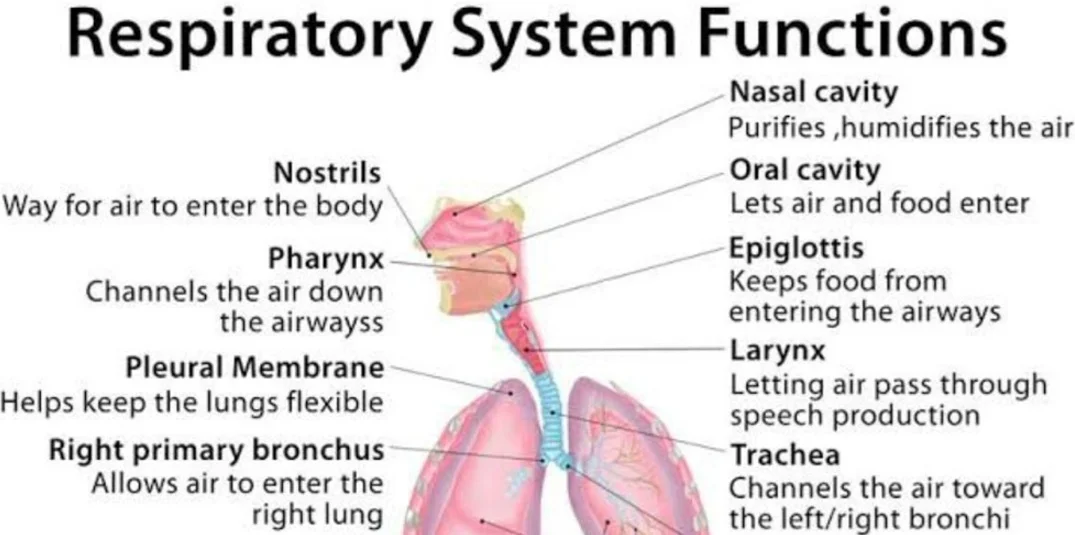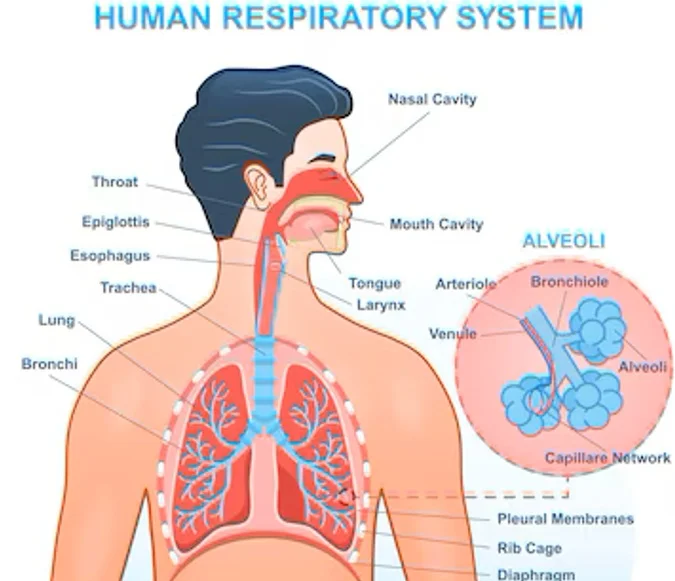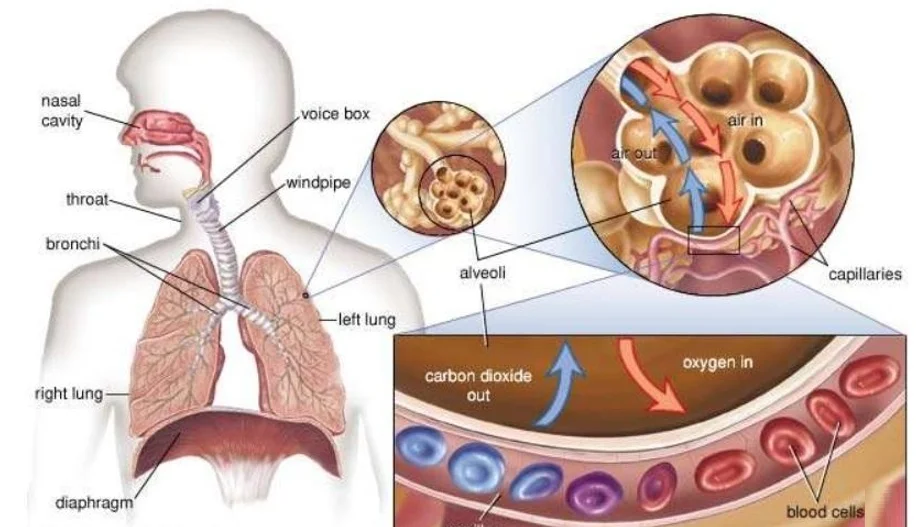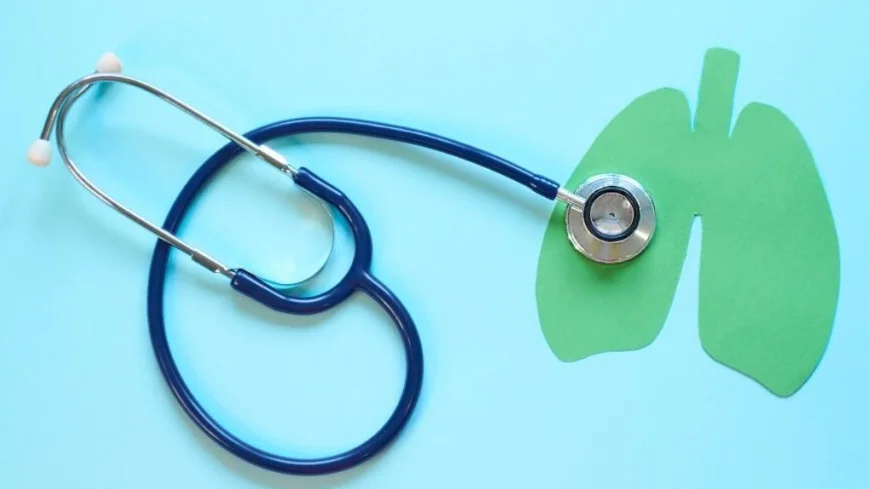Respiratory System
Respiratory System Guide - Available for download in PDF
The respiratory system is the body’s network of organs and tissues that help you breathe. It includes the nose, throat, windpipe, lungs, and diaphragm. This system allows oxygen to enter the bloodstream and removes carbon dioxide, a waste product of metabolism. Breathing is the process that powers the exchange of gases, essential for energy production and overall survival.
It is shaped by the respiratory tract and the lungs. The organs that make up the respiratory tract are: nasal cavities, pharynx, larynx, trachea and bronchi.
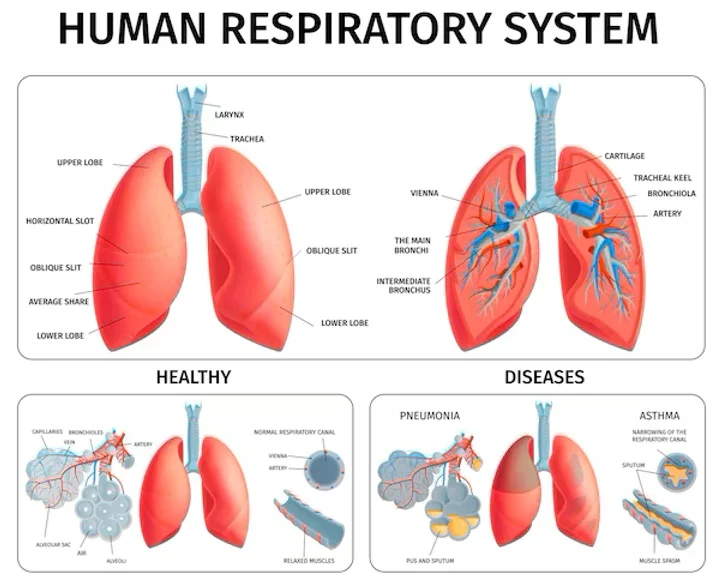 Functions of the Respiratory System
Functions of the Respiratory System
The respiratory system performs several important functions vital for life. Its primary role is gas exchange, letting oxygen to enter the bloodstream and removing carbon dioxide, a waste product of metabolism. It helps regulate blood pH by controlling carbon dioxide levels, certifying the body’s acid-base balance. The system also supports sound production over the vocal cords and facilitates the sense of smell via the nasal passages. Moreover, it protects the body by filtering and trapping particles like dust and microbes, preventing them from incoming the lungs. These functions collectively maintain the body’s health and homeostasis.
Each of the organs in the Respiratory System supports keep the body’s balance. Learn about the functions performed by the Respiratory System under.
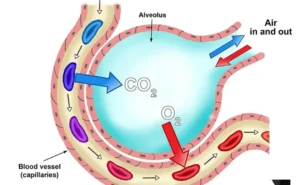 It brings oxygen into the body and removes carbon dioxide through the lungs. When we inhale atmospheric air, which holds oxygen and other chemical elements, it passes through the respiratory tract and influences the lungs.
It brings oxygen into the body and removes carbon dioxide through the lungs. When we inhale atmospheric air, which holds oxygen and other chemical elements, it passes through the respiratory tract and influences the lungs.
The exchange of carbon dioxide for oxygen takes place in the lungs. And, thanks to the respiratory muscles, this organ creates forces for the air to flow. All of this is done through stimuli and commands issued by the Central Nervous System.
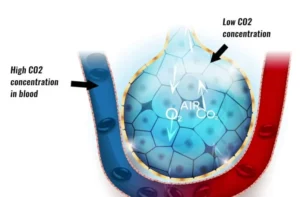 Acid-base balance states to the regulation of the body’s pH levels to maintain a stable internal atmosphere. The body needs a slightly alkaline pH, typically around 7.35 to 7.45, for correct cellular function. The respiratory system plays a crucial role in this process by controlling the levels of carbon dioxide in the blood. When carbon dioxide dissolves in blood, it forms carbonic acid, which can lower pH. Breathing faster (hyperventilation) removes more carbon dioxide, raising pH, while slower breathing (hypoventilation) retains carbon dioxide, lowering pH. This balance is vital for enzymes and biochemical reactions to function effectively in the body.
Acid-base balance states to the regulation of the body’s pH levels to maintain a stable internal atmosphere. The body needs a slightly alkaline pH, typically around 7.35 to 7.45, for correct cellular function. The respiratory system plays a crucial role in this process by controlling the levels of carbon dioxide in the blood. When carbon dioxide dissolves in blood, it forms carbonic acid, which can lower pH. Breathing faster (hyperventilation) removes more carbon dioxide, raising pH, while slower breathing (hypoventilation) retains carbon dioxide, lowering pH. This balance is vital for enzymes and biochemical reactions to function effectively in the body.
Acid-base balance corresponds to the removal of excess CO2 from the body.
In this function, we again have the role of the Nervous System, which is responsible for sending information to the breathing controllers.
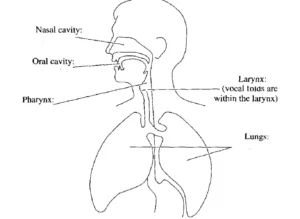 The vocal cords in the larynx produce sound as air passes through.
The vocal cords in the larynx produce sound as air passes through.
The production and emission of sounds is carried out by the joint action of the Nervous System and the muscles that work in breathing.
They are what allow the flow of air from the vocal cords and mouth.
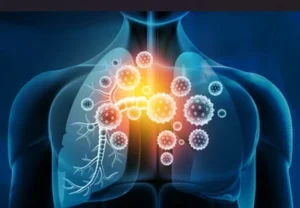 The lungs have several defense mechanisms to defend against harmful particles, pathogens, and irritants. The mucociliary escalator traps dust, microbes, and debris in mucus, which cilia then move upward for expulsion or swallowing. Immune cells, like macrophages, actively destroy pathogens and foreign particles. Reflex actions such as coughing and sneezing help expel irritants, while the nose filters large particles and humidifies the air before it reaches the lungs. Additionally, antimicrobial substances in the mucus neutralize microbes, and the tight junctions in airway cells form a barrier to prevent harmful substances from entering the bloodstream. Together, these mechanisms ensure the lungs remain healthy and functional.
The lungs have several defense mechanisms to defend against harmful particles, pathogens, and irritants. The mucociliary escalator traps dust, microbes, and debris in mucus, which cilia then move upward for expulsion or swallowing. Immune cells, like macrophages, actively destroy pathogens and foreign particles. Reflex actions such as coughing and sneezing help expel irritants, while the nose filters large particles and humidifies the air before it reaches the lungs. Additionally, antimicrobial substances in the mucus neutralize microbes, and the tight junctions in airway cells form a barrier to prevent harmful substances from entering the bloodstream. Together, these mechanisms ensure the lungs remain healthy and functional.
When breathing, it is practically impossible to eliminate the impurities contained in the atmospheric environment. Inhaling microorganisms becomes inevitable.
To avoid health problems, the Respiratory System has Défense mechanisms, which in turn are carried out through the action of different organs.
Find out below which organs make up the Respiratory System and how they work in our body.
Organs of the Respiratory System
The respiratory system includes the nose, nasal cavity, pharynx, larynx, trachea, bronchi, and lungs. These organs work together to facilitate breathing, oxygen exchange, and the removal of carbon dioxide.
Several organs act in the Respiratory System
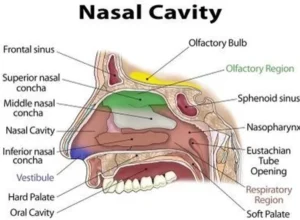 The nasal cavities are hollow spaces within the nose, divided by the nasal septum, that warm, moisten, and filter incoming air. They also house receptors for the sense of smell and play a role in resonating the voice.
The nasal cavities are hollow spaces within the nose, divided by the nasal septum, that warm, moisten, and filter incoming air. They also house receptors for the sense of smell and play a role in resonating the voice.
The nasal cavities are two parallel passages lined with mucosa and separated by a cartilaginous septum, which begin at the nostrils and end at the pharynx.
Inside the nasal cavities, there are hairs that act as an air filter, retaining impurities and germs, ensuring that the air reaches the lungs clean.
The membrane lining the nasal cavities contains mucus-producing cells that humidify the air. It is rich in blood vessels that warm the air entering the nose.
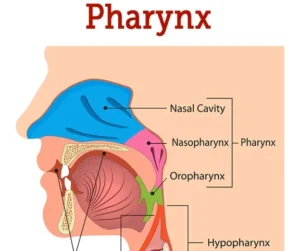 The pharynx, commonly known as the throat, is a muscular tube that connects the nasal cavity and mouth to the larynx and esophagus. It serves as a passageway for both air (to the respiratory system) and food (to the digestive system).
The pharynx, commonly known as the throat, is a muscular tube that connects the nasal cavity and mouth to the larynx and esophagus. It serves as a passageway for both air (to the respiratory system) and food (to the digestive system).
The pharynx is a tube that serves as a passage for both food and air, therefore, it is part of the respiratory system and the digestive system.
Its upper end communicates with the nasal cavities and the mouth, and its lower end communicates with the larynx and the esophagus. Its walls are muscular and lined with mucosa.
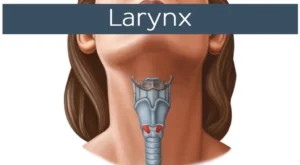 The larynx, also known as the voice box, is a structure located in the neck that houses the vocal cords. It plays a key role in breathing, producing sound, and protecting the trachea from food aspiration by preventing the entry of foreign particles into the airway.
The larynx, also known as the voice box, is a structure located in the neck that houses the vocal cords. It plays a key role in breathing, producing sound, and protecting the trachea from food aspiration by preventing the entry of foreign particles into the airway.
The larynx is the organ that connects the pharynx to the trachea. At the top of the larynx is the epiglottis, the valve that closes during swallowing.
This is also the main organ of speech. The vocal cords are located here.
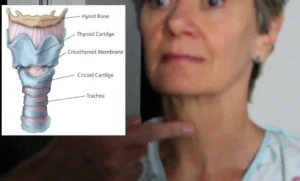 The trachea, commonly known as the windpipe, is a tube that connects the larynx to the bronchi of the lungs. It serves as a passageway for air, allowing it to move in and out of the lungs during breathing. The trachea is lined with cilia and mucus to filter out particles and pathogens.
The trachea, commonly known as the windpipe, is a tube that connects the larynx to the bronchi of the lungs. It serves as a passageway for air, allowing it to move in and out of the lungs during breathing. The trachea is lined with cilia and mucus to filter out particles and pathogens.
The trachea is a tube located below the larynx and formed by fifteen to twenty cartilaginous rings that keep it open.
This organ is covered by a mucous membrane, and the air is heated, humidified and filtered through it.
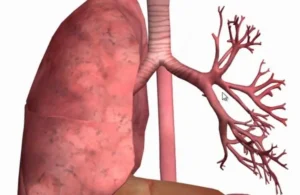 The bronchi are the two main branches that stem from the trachea and carry air into each lung. They further divide into smaller bronchioles within the lungs, allowing air to reach the alveoli, where gas exchange occurs.
The bronchi are the two main branches that stem from the trachea and carry air into each lung. They further divide into smaller bronchioles within the lungs, allowing air to reach the alveoli, where gas exchange occurs.
The trachea, bronchus, bronchioles and alveoli perform important functions
The bronchi are two branches of the trachea also formed by cartilaginous rings.
Each bronchus enters one of the lungs and divides into several smaller branches, which are distributed throughout the organ, forming the bronchioles.
The bronchi branch and subdivide several times, forming the bronchial tree.
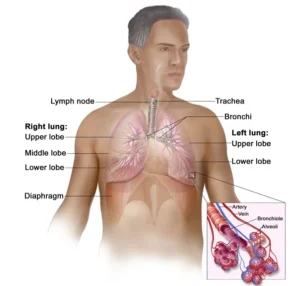 The lungs are a pair of spongy, air-filled organs located in the chest that are responsible for gas exchange. They take in oxygen from the air and remove carbon dioxide from the bloodstream, playing a crucial role in respiration and overall body function.
The lungs are a pair of spongy, air-filled organs located in the chest that are responsible for gas exchange. They take in oxygen from the air and remove carbon dioxide from the bloodstream, playing a crucial role in respiration and overall body function.
Details of the Bronchi, Bronchioles and Alveoli and gas exchange
The respiratory system is made up of two lungs , spongy organs located in the rib cage. They are responsible for exchanging oxygen for carbon dioxide through breathing.
Each lung is surrounded by a double membrane called the pleura. Inside, each lung has about 200 million very small, grape-shaped, air-filled structures called pulmonary alveoli.
Each alveolus receives branches from a bronchiole. In the alveoli, gas exchange takes place between the environment, called hematosis. All of this happens thanks to the very thin membranes that cover them and house numerous very fine blood vessels, the capillaries.
Diseases of the Respiratory System
Diseases of the respiratory system are conditions that affect the lungs and airways, impairing normal breathing and oxygen exchange. These diseases can be caused by infections, environmental factors, genetics, or other health issues.
The lungs can be attacked by various diseases, which can be infectious or allergic.
List of common respiratory diseases:
- Asthma – A chronic condition where the airways become inflamed and narrow, causing difficulty breathing.
- Chronic Obstructive Pulmonary Disease (COPD) – A group of diseases, including emphysema and chronic bronchitis, that cause long-term breathing problems.
- Pneumonia – An infection of the lungs that causes inflammation and fluid buildup, making it hard to breathe.
- Tuberculosis (TB) – A bacterial infection that primarily affects the lungs, causing cough, fever, and chest pain.
- Lung Cancer – A type of cancer that starts in the lungs and may spread to other parts of the body.
- Bronchitis – Inflammation of the bronchial tubes, often caused by infections or smoking, leading to coughing and mucus production.
- Pulmonary Fibrosis – A condition where lung tissue becomes scarred, making it difficult to breathe.
- Sleep Apnea – A disorder where breathing repeatedly stops and starts during sleep, leading to poor sleep quality.
- Cystic Fibrosis – A genetic disorder that causes thick mucus to build up in the lungs, leading to respiratory infections and difficulty breathing.
These diseases can range from mild to severe and may require medical treatment to manage symptoms and improve quality of life.
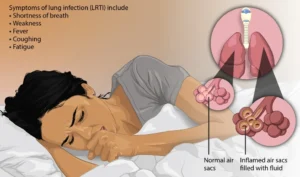 Infectious diseases of the respiratory system are illnesses caused by pathogens like bacteria, viruses, fungi, or parasites that affect the lungs and airways, leading to breathing problems and other related symptoms. These infections can range from mild to severe and are often spread through coughing, sneezing, or close contact with infected individuals.
Infectious diseases of the respiratory system are illnesses caused by pathogens like bacteria, viruses, fungi, or parasites that affect the lungs and airways, leading to breathing problems and other related symptoms. These infections can range from mild to severe and are often spread through coughing, sneezing, or close contact with infected individuals.
Infectious diseases are the result of inflammation in certain organs. They are caused by microorganisms, such as viruses, bacteria, and other parasites.
The infectious process can also be triggered by toxic substances, such as toxic cigarette smoke, which is what happens in emphysema, a chronic degenerative disease, generally triggered by smoking.
Among the best-known infectious diseases are: flu, colds, tuberculosis, pneumonia and pulmonary emphysema.
List of common infectious diseases of the respiratory system:
- Pneumonia – An infection that inflames the air sacs in the lungs, which may fill with fluid or pus, causing coughing, fever, and difficulty breathing.
- Tuberculosis (TB) – A bacterial infection primarily affecting the lungs, characterized by a persistent cough, weight loss, and fatigue.
- Influenza (Flu) – A viral infection that causes fever, chills, sore throat, body aches, and respiratory symptoms.
- COVID-19 – A viral infection caused by the SARS-CoV-2 virus, leading to symptoms ranging from mild cold-like symptoms to severe respiratory distress.
- Common Cold – A viral infection that affects the upper respiratory tract, causing a runny nose, cough, and sore throat.
- Bronchitis – An inflammation of the bronchial tubes, often caused by a viral infection, leading to coughing and mucus production.
- Whooping Cough (Pertussis) – A highly contagious bacterial infection marked by severe coughing fits and difficulty breathing, particularly in infants and young children.
- Sinusitis – An infection or inflammation of the sinuses that can lead to congestion, facial pain, and difficulty breathing through the nose.
- Respiratory Syncytial Virus (RSV) – A viral infection, particularly dangerous for infants and older adults, causing bronchiolitis and pneumonia-like symptoms.
These infectious diseases can often be prevented through vaccination, hygiene practices, and proper treatment with antibiotics or antiviral medications when necessary.
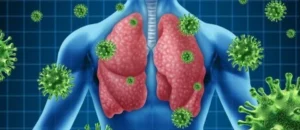 Allergic diseases of the respiratory system occur when the body’s immune system overreacts to harmless substances, such as pollen, dust, or pet dander, causing inflammation in the airways and respiratory discomfort. These conditions are typically triggered by allergens and can cause symptoms like coughing, wheezing, shortness of breath, and nasal congestion.
Allergic diseases of the respiratory system occur when the body’s immune system overreacts to harmless substances, such as pollen, dust, or pet dander, causing inflammation in the airways and respiratory discomfort. These conditions are typically triggered by allergens and can cause symptoms like coughing, wheezing, shortness of breath, and nasal congestion.
The respiratory system is also attacked by allergic diseases, which result from the body’s hypersensitivity to a certain agent: dust, medicines, cosmetics, pollen, etc.
Examples of allergic diseases include: rhinitis, bronchitis and asthma.
List of common allergic diseases of the respiratory system:
- Asthma – A chronic condition where the airways become inflamed and narrow in response to allergens, causing difficulty breathing, wheezing, and coughing.
- Allergic Rhinitis (Hay Fever) – An allergic reaction to airborne allergens such as pollen, dust, or mold, causing sneezing, nasal congestion, and itchy eyes.
- Allergic Bronchitis – Inflammation of the bronchial tubes triggered by allergens, leading to coughing, wheezing, and shortness of breath.
- Allergic Sinusitis – Inflammation of the sinuses due to an allergic reaction, causing facial pain, congestion, and difficulty breathing through the nose.
- Chronic Rhinosinusitis with Nasal Polyps – A long-term condition where inflammation in the nasal passages and sinuses causes nasal polyps, leading to breathing difficulties, sinus pressure, and loss of smell.
These allergic conditions are often managed with medications like antihistamines, nasal corticosteroids, and inhalers to reduce inflammation and control symptoms. Avoiding known allergens is also an important preventive measure.
Curiosity about the Respiratory System
The respiratory system is fascinating in many ways, from its complexity to its essential role in sustaining life.
No system in our body acts alone. In dangerous situations, for example, the Respiratory System and the Nervous System act together.
In dangerous situations, our body reacts in different ways, one of which is rapid breathing. This happens because the body needs to absorb more oxygen.
The sympathetic nervous system releases adrenaline and noradrenaline and, in parallel, hormones are produced by the pituitary gland, causing these sensations and reactions in the body.
Here are some more interesting facts:
- Breathing Rate: On average, humans breathe about 16-20 times per minute, but this can increase with physical activity or stress. Over a lifetime, this adds up to millions of breaths!
- Oxygen and Carbon Dioxide Exchange: The lungs are responsible for the exchange of oxygen and carbon dioxide. Oxygen enters the bloodstream through tiny air sacs called alveoli, while carbon dioxide, a waste product of metabolism, is expelled from the body.
- Lung Capacity: The average adult’s lungs can hold about 6 Liters of air, but only about 500 millilitres are typically exchanged with each breath during normal breathing.
- Self-Cleaning Mechanism: The respiratory system has a natural cleaning system, with mucus and cilia (tiny hair-like structures) in the airways that trap and remove dust, bacteria, and other particles.
- The Nose Knows: The nose is not just for smelling; it filters, warms, and humidifies the air before it reaches the lungs, which helps prevent irritation and infection.
- The Diaphragm’s Role: The diaphragm, a large muscle below the lungs, plays a key role in breathing by contracting and relaxing to control lung expansion and air intake.
- The Vocal Cords: The larynx, or voice box, houses the vocal cords, which vibrate as air passes through, producing sound for speech and communication.
- Lung Regeneration: Although lung tissue is not as regenerative as other organs like the liver, it can repair itself to some extent, especially after damage due to smoking or disease, although the process is slower and limited.
The respiratory system is constantly working, even while we sleep, and is intricately connected to nearly every other system in the body. It’s essential for maintaining life and overall health.
Download Respiratory System in PDF
